International Journal of Intelligent Systems and Applications @ijisa
Статьи журнала - International Journal of Intelligent Systems and Applications
Все статьи: 1214
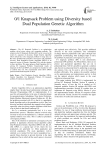
0/1 Knapsack Problem using Diversity based Dual Population Genetic Algorithm
Статья научная
The 0/1 Knapsack Problem is an optimization problem solved using various soft computing methods. The solution to the 0/1 Knapsack Problem (KP) can be viewed as the result of a sequence of decisions. Simple Genetic Algorithm (SGA) effectively solves knapsack problem for large data set. But it has problems like premature convergence and population diversity. Dual Population Genetic Algorithm (DPGA) is an improved version of Genetic Algorithm (GA) with the solution to above problems. This paper proposes Dual Population GA for solving 0/1 knapsack Problem. Experimental results of knapsack on SGA and DPGA are compared on standard as well as random data sets. The experimental result shows DPGA performs better than knapsack on SGA.
Бесплатно
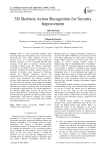
3D skeleton action recognition for security improvement
Статья научная
Most of action recognition methods allow achieving high action recognition accuracy, but only after processing the entire video sequence, however, for security issues, it is primordial to detect dangerous behavior occurrence as soon as possible allowing early warnings. In this paper, we present a human activity recognition method using 3D skeleton information, recovered by an RGB-D sensor by proposing a new descriptor modeling the dynamic relation between 3D locations of skeleton joints expressed in Euclidean distance and spherical coordinates between the normalized joints, A PCA dimension reduction is used to remove noisy information and enhance recognition accuracy while improving calculation and decision time. We also study the accuracy of the proposed descriptor calculated on limited few first frames and using limited skeleton joint number, to perform early action detection by exploring several classifiers. We test this approach on two datasets, MSR Daily Activity 3D and our own dataset called INDACT. Experimental evaluation shows that the proposed approach can robustly classify actions outperforming state-of-the-art methods and maintain good accuracy score even using limited frame number and reduced skeleton joints.
Бесплатно
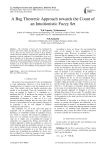
A Bag Theoretic Approach towards the Count of an Intuitionistic Fuzzy Set
Статья научная
The cardinality of fuzzy sets was introduced by DeLuca and termini, Zadeh and Tripathy et al, where the first one is a basic one, the second one is based on fuzzy numbers and the final one introduces a bag theoretic approach. The only approach to find the cardinality of an intuitionistic fuzzy set is due to Tripathy et al. In this paper, we introduce a bag theoretic approach to find the cardinality of intuitionistic fuzzy set, which extends the corresponding definition of fuzzy sets introduced by Tripathy et al. In fact three types of intuitionistic fuzzy counts are introduced and we also establish several properties of these count functions.
Бесплатно
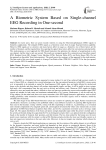
A Biometric System Based on Single-channel EEG Recording in One-second
Статья научная
In recent years, there are great research interests in using the Electroencephalogram (EEG) signals in biometrics applications. The strength of EEG signals as a biometric comes from its major fraud prevention capability. However, EEG signals are so sensitive, and many factors affect its usage as a biometric; two of these factors are the number of channels, and the required time for acquiring the signal; these factors affect the convenience and practicality. This study proposes a novel approach for EEG-based biometrics that optimizes the channels of acquiring data to only one channel. And the time to only one second. The results are compared against five commonly used classifiers named: KNN, Random Forest (RF), Support Vector Machine (SVM), Decision Tables (DT), and Naïve Bayes (NB). We test the approach on the public Texas data repository. The results prove the constancy of the approach for the eight minutes. The best result of the eyes-closed scenario is Average True Positive Rate (TPR) 99.1% and 98.2% for the eyes-opened. And it reaches 100% for multiple subjects.
Бесплатно
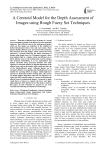
A Centroid Model for the Depth Assessment of Images using Rough Fuzzy Set Techniques
Статья научная
Detection of affected areas in images is a crucial step in assessing the depth of the affected area for municipal operators. These affected areas in the underground images, which are line images are indicative of the condition of buried infrastructures like sewers and water mains. These images identify affected areas and extract their properties like structures from the images, whose contrast has been enhanced... A Centroid Model for the Depth Assessment of Images using Rough Fuzzy Set Techniques presents a three step method which is a simple, robust and efficient one to detect affected areas in the underground concrete images. The proposed methodology is to use segmentation and feature extraction using structural elements. The main objective for using this model is to find the dimensions of the affected areas such as the length, width, depth and the type of the defects/affected areas. Although human eye is extremely effective at recognition and classification, it is not suitable for assessing defects in images, which might have spread over thousands of miles of image lines. The reasons are mainly fatigue, subjectivity and cost. Our objective is to reduce the effort and the labour of a person in detecting the affected areas in underground images. A proposal to apply rough fuzzy set theory to compute the lower and upper approximations of the affected area of the image is made in this paper. In this connection we propose to use some concepts and technology developed by Pal and Maji.
Бесплатно
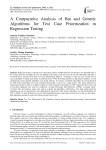
Статья научная
Regression testing is carried out to ensure that software modifications do not introduce new potential bugs to the existing software. Existing test cases are applied in the testing, such test cases can run into thousands, and there is not much time to execute all of them. Test Case Prioritization (TCP) is a technique to order test cases so that the test cases potentially revealing more faults are performed first. With TCP being deemed an optimization problem, several metaheuristic nature-inspired algorithms such as Bat, Genetic, Ant colony, and Firefly algorithms have been proposed for TCP. These algorithms have been compared theoretically or based on a single metric. This study employed an experimental design to offer an in-depth comparison of bat and genetic algorithms for TCP. Unprioritized test cases and a brute-force approach were used for comparison. Average Percentage Fault Detection (APFD)- a popular metric, execution time and memory usage were used to evaluate the algorithms’ performance. The study underscored the importance of test case prioritization and established the superiority of the Genetic algorithm over the bat algorithm for TCP in APFD. No stark differences were recorded regarding memory usage and execution time for the two algorithms. Both algorithms seemed to scale well with the growth of test cases.
Бесплатно
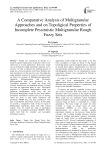
Статья научная
Rough sets, introduced by Pawlak as a model to capture impreciseness in data have been a very useful tool in several applications. These basic rough sets are defined by taking equivalence relations over a universe. In order to enhance the modeling powers of rough sets, several extensions to the basic definition has been introduced over the past few years. Extending the single granular structure of research in classical rough set theory two notions of Multigranular approaches; Optimistic Multigranulation and Pessimistic Multigranulation have been introduced so far. Topological properties of rough sets along with accuracy measures are two important features of rough sets from the application point of view. Topological properties of Optimistic Multigranular rough sets Optimistic Multigranular rough fuzzy sets and Pessimistic Multigranular rough sets have been studied. Incomplete information systems take care of missing values for items in data tables. Optimistic and pessimistic MGRS have also been extended to such type of incomplete information systems. In this paper we provide a comparative study of the two types of Multigranular approaches along with other related notions. Also, we extend the study to topological properties of incomplete pessimistic MGRFS. These results hold both for complete and incomplete information systems.
Бесплатно
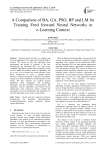
Статья научная
Training neural networks is a complex task of great importance in the supervised learning field of research. We intend to show the superiority (time performance and quality of solution) of the new metaheuristic bat algorithm (BA) over other more “standard” algorithms in neural network training. In this work we tackle this problem with five algorithms, and try to over a set of results that could hopefully foster future comparisons by using a standard dataset (Proben1: selected benchmark composed of problems arising in the field of Medicine) and presentation of the results. We have selected two gradient descent algorithms: Back propagation and Levenberg-Marquardt, and three population based heuristic: Bat Algorithm, Genetic Algorithm, and Particle Swarm Optimization. Our conclusions clearly establish the advantages of the new metaheuristic bat algorithm over the other algorithms in the context of eLearning.
Бесплатно
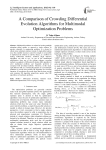
A Comparison of Crowding Differential Evolution Algorithms for Multimodal Optimization Problems
Статья научная
Multimodal problems are related to locating multiple, redundant global optima, as opposed to single solution. In practice, generally in engineering problems it is desired to obtain many redundant solutions instead of single global optima since the available resources cannot be enough or not possible to implement the solution in real-life. Hence, as a toolbox for finding multimodal solutions, modified single objective algorithms can able to use. As one of the fundamental modification, from one of the niching schemes, crowding method was applied to Differential Evolution (DE) algorithm to solve multimodal problems and frequently preferred to compared with developed methods. Therefore, in this study, eight different DE are considered/evaluated on ten benchmark problems to provide best possible DE algorithm for crowding operation. In conclusion, the results show that the time varying scale mutation DE algorithm outperforms against other DE algorithms on benchmark problems.
Бесплатно
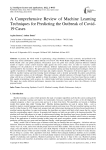
A Comprehensive Review of Machine Learning Techniques for Predicting the Outbreak of COVID-19 Cases
Статья научная
At present, the whole world is experiencing a huge disturbance in social, economic, and political levels which may mostly attributed to sudden outbreak of Covid-19. The World Health Organization (WHO) declared it as Public Health crisis and global pandemic. Researchers across the globe have already proposed different outbreak models to impose various control measures fight against the novel corona virus. In order to overcome various challenges for the prediction of Covid-19 outbreaks, different mathematical and statistical approaches have been recommended by the researchers. The approaches used machine learning and deep learning based techniques which are capable of prediction of hidden patterns from large and complex datasets. The purpose of the present paper is to study different machine learning and deep learning based techniques used to identify and predict the pattern and performs some comparative analysis on the techniques. This paper contains a detailed summary of 40 paper based on this issue along with the use of method they applied to obtain the purpose. After the review it has been found that no model is fully capable of predicting it with accuracy. So, a hybrid model with better training should be employed for better result. This paper also studies different performance measures that researchers have used to show the efficiency of their proposed model.
Бесплатно
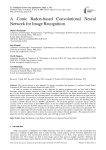
A Conic Radon-based Convolutional Neural Network for Image Recognition
Статья научная
This article presents a new approach for image recognition that proposes to combine Conical Radon Transform (CRT) and Convolutional Neural Networks (CNN). In order to evaluate the performance of this approach for pattern recognition task, we have built a Radon descriptor enhancing features extracted by linear, circular and parabolic RT. The main idea consists in exploring the use of Conic Radon transform to define a robust image descriptor. Specifically, the Radon transformation is initially applied on the image. Afterwards, the extracted features are combined with image and then entered as an input into the convolutional layers. Experimental evaluation demonstrates that our descriptor which joins together extraction of features of different shapes and the convolutional neural networks achieves satisfactory results for describing images on public available datasets such as, ETH80, and FLAVIA. Our proposed approach recognizes objects with an accuracy of 96 % when tested on the ETH80 dataset. It also has yielded competitive accuracy than state-of-the-art methods when tested on the FLAVIA dataset with accuracy of 98 %. We also carried out experiments on traffic signs dataset GTSBR. We investigate in this work the use of simple CNN models to focus on the utility of our descriptor. We propose a new lightweight network for traffic signs that does not require a large number of parameters. The objective of this work is to achieve optimal results in terms of accuracy and to reduce network parameters. This approach could be adopted in real time applications. It classified traffic signs with high accuracy of 99%.
Бесплатно

A Dataset Centric Feature Selection and Stacked Model to Detect Breast Cancer
Статья научная
World Health Organisation declared breast cancer (BC) as the most frequent suffering among women and accounted for 15 percent of all cancer deaths. Its accurate prediction is of utmost significance as it not only prevents deaths but also stops mistreatments. The conventional way of diagnosis includes the estimation of the tumor size as a sign of plausible cancer. Machine learning (ML) techniques have shown the effectiveness of predicting disease. However, the ML methods have been method centric rather than being dataset centric. In this paper, the authors introduce a dataset centric approach(DCA) deploying a genetic algorithm (GA) method to identify the features and a learning ensemble classifier algorithm to predict using the right features. Adaboost is such an approach that trains the model assigning weights to individual records rather than experimenting on the splitting of datasets alone and perform hyper-parameter optimization. The authors simulate the results by varying base classifiers i.e, using logistic regression (LR), decision tree (DT), support vector machine (SVM), naive bayes (NB), random forest (RF), and 10-fold cross-validations with a different split of the dataset as training and testing. The proposed DCA model with RF and 10-fold cross-validations demonstrated its potential with almost 100% performance in the classification results that no research could suggest so far. The DCA satisfies the underlying principles of data mining: the principle of parsimony, the principle of inclusion, the principle of discrimination, and the principle of optimality. This DCA is a democratic and unbiased ensemble approach as it allows all features and methods in the start to compete, but filters out the most reliable chain (of steps and combinations) that give the highest accuracy. With fewer characteristics and splits of 50-50, 66-34, and 10 fold cross-validations, the Stacked model achieves 97 % accuracy. These values and the reduction of features improve upon prior research works. Further, the proposed classifier is compared with some state-of-the-art machine-learning classifiers, namely random forest, naive Bayes, support-vector machine with radial basis function kernel, and decision tree. For testing the classifiers, different performance metrics have been employed – accuracy, detection rate, sensitivity, specificity, receiver operating characteristic, area under the curve, and some statistical tests such as the Wilcoxon signed-rank test and kappa statistics – to check the strength of the proposed DCA classifier. Various splits of training and testing data – namely, 50–50%, 66–34%, 80–20% and 10-fold cross-validation – have been incorporated in this research to test the credibility of the classification models in handling the unbalanced data. Finally, the proposed DCA model demonstrated its potential with almost 100% performance in the classification results. The output results have also been compared with other research on the same dataset where the proposed classifiers were found to be best across all the performance dimensions.
Бесплатно
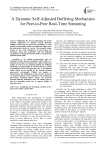
A Dynamic Self-Adjusted Buffering Mechanism for Peer-to-Peer Real-Time Streaming
Статья научная
Multimedia live stream multicasting and on-line real-time applications are popular recently. Real-time multicast system can use peer-to-peer technology to keep stability and scalability without any additional support from the underneath network or a server. Our proposed scheme focuses on the mesh architecture of peer-to-peer live streaming system and experiments with the buffering mechanisms. We design the dynamic buffer to substitute the traditional fixed buffer. According to the existing measurements and our simulation results, using the traditional static buffer in a dynamic peer-to-peer environment has a limit of improving quality of service. In our proposed method, the buffering mechanism can adjust buffer to avoid the frozen or reboot of streaming based on the input data rate. A self-adjusted buffer control can be suitable for the violently dynamic peer-to-peer environment. Without any support of infrastructure and modification of peer-to-peer protocols, our proposed scheme can be workable in any chunk-based peer-to-peer streaming delivery. Hence, our proposed dynamic buffering mechanism varies the existing peer-to-peer live streaming system less to improve quality of experience more.
Бесплатно
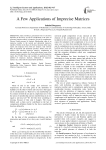
A Few Applications of Imprecise Matrices
Статья научная
This article introduces generalized form of extension definition of the Fuzzy set and its complement in the sense of reference function namely in imprecise set and its complement. Discuss Partial presence of element, Membership value of an imprecise number in the normal and subnormal imprecise numbers. Further on the basis of reference function define usual matrix into imprecise form with new notation. And with the help of maximum and minimum operators, obtain some new matrices like reducing imprecise matrices, complement of reducing imprecise matrix etc. Along with discuss some of the classical matrix properties which are hold good in the imprecise matrix also. Further bring out examples of application of the addition of imprecise matrices, subtraction of imprecise matrices etc. in the field of transportation problems.
Бесплатно
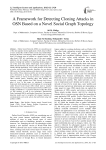
A Framework for Detecting Cloning Attacks in OSN Based on a Novel Social Graph Topology
Статья научная
Online Social Networks (OSN) are considering one of the most popular internet applications which attract millions of users around the world to build several social relationships. Emerging the Web 2.0 technology allowed OSN users to create, share, or exchange types of contents in a popular fashion. The other hand, OSN are considering one of the most popular platforms for the intruders to spread several types of OSN attacks. Creating fake profiles for launching cloning attacks is one of the most risky attacks which target Users' profiles in Online Social Networks, the attacker seek to impersonate user's identity through duplicating user's online presence in the same or across several social networks, therefore, he can deceive OSN users into forming trusting social relations with his created fake profiles. These malicious profiles aim to harvest sensitive user's information or misuse the reputation of the legitimate profile's owner, as well as it may be used as a spy profiles for other criminal parties. Detecting these fake profiles still represent a major problem from OSN Security and Privacy point of view. In this paper we introduced a theoretical framework which depends on a novel topology of a social graph called Trusted Social Graph (TSG) which used to visualize trusted instances of social communications between OSN users. Another contribution is a proposed detection model that based on TSG topology as well as two techniques; Deterministic Finite Automaton (DFA) and Regular Expression. Our proposed detection model used to recognize the stranger instances of communications and social actions that performed using fake profiles in OSN.
Бесплатно
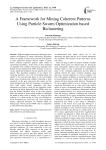
A Framework for Mining Coherent Patterns Using Particle Swarm Optimization based Biclustering
Статья научная
High-throughput microarray technologies have enabled development of robust biclustering algorithms which are capable of discovering relevant local patterns in gene expression datasets wherein subset of genes shows coherent expression patterns under subset of experimental conditions. In this work, we have proposed an algorithm that combines biclustering technique with Particle Swarm Optimization (PSO) structure in order to extract significant biological relevant patterns from such dataset. This algorithm comprises of two phases for extracting biclusters, one is the seed finding phase and another is the seed growing phase. In the seed finding phase, gene clustering and condition clustering is done separately on the gene expression data matrix and the result obtained from both the clustering is combined to form small tightly bound submatrices and those submatrices are used as seeds for the algorithm, which are having the Mean Squared Residue (MSR) value less than the defined threshold value. In the seed growing phase, the number of genes and the number of conditions are added in these seeds to enlarge it by using the PSO structure. It is observed that by using our technique in Yeast Saccharomyces Cerevisiae cell cycle expression dataset, significant biclusters are obtained which are having large volume and less MSR value in comparison to other biclustering algorithms.
Бесплатно
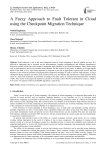
A Fuzzy Approach to Fault Tolerant in Cloud using the Checkpoint Migration Technique
Статья научная
Fault tolerance is one of the most important issues in cloud computing to provide reliable services. It is difficult to implement due to dynamic service infrastructures, complex configurations and different dependencies. Extensive research efforts have been made to implement fault tolerance in the cloud environment. Many studies focus only on fault detection and do not consider fault tolerance. For this reason, in this paper, in addition to recognizing the nature of the fault, a fuzzy logic-based approach is proposed to provide an appropriate response and increase the fault tolerance in the cloud environment. Checkpoint-based migration technique is used to increase fault tolerance. Using a checkpoint during migration can reduce time and processing costs and balance the load between virtual machines in the event of a fault. The simulation is performed according to the data center of Vietnam Telecommunications Company (VDC). The results of the proposed method in a period of 60 minutes show 98.03% fault detection accuracy, which is 4.5% and 4.1% superior to FLPT and PLBFT algorithms, respectively.
Бесплатно

A General Framework for Multi-Objective Optimization Immune Algorithms
Статья научная
Artificial Immune System (AIS) is a hotspot in the area of Computational Intelligence. While the Multi-Objective Optimization (MOP) problem is one of the most widely applied NP-Complete problems. During the past decade more than ten kinds of Multi-Objective optimization algorithms based on AIS were proposed and showed outstanding abilities in solving this kind of problem. The paper presents a general framework of Multi-Objective Immune Algorithms, which summarizes a uniform outline of this kind of algorithms and gives a description of its principles, mainly used operators and processing methods. Then we implement the proposed framework and build four typical immune algorithms on it: CLONALG, MISA, NNIA and CMOIA. The experiment results showed the framework is very suitable to develop the various multi-objective optimization immune algorithms.
Бесплатно
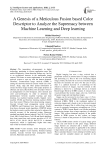
Статья научная
The tremendous advancements in digital technology pertaining to diverse application areas like medical diagnostics, crime detection, defense etc., has led to an exceptional increase in the multimedia image content. This bears an acute requirement of an effectual retrieval system to cope up with the human demands. Therefore, Content-based image retrieval (CBIR) is among the renowned retrieval systems which uses color, texture, shape, edge and other spatial information to extract the basic image features. This paper proposes an efficient and unexcelled hybrid color descriptor which is an amalgamation of color histogram, color moment and color auto-correlogram. In order to determine the predominance between machine learning and deep learning, two machine learning models, Support vector machine (SVM) and Extreme learning machine (ELM) have been tested. Whereas from deep learning category, Cascade forward back propagation neural network (CFBPNN) and Patternnet have been utilized. Finally, from these divergent tested algorithms, CFBPNN attains the highest accuracy and has been selected to enhance the retrieval accuracy of the proposed system. Numerous standard benchmark datasets namely Corel-1K, Corel-5K, Corel-10K, Oxford flower, Coil-100 and Zurich buildings have been tested here and average precision of 97.1%, 90.3%, 87.9%, 98.4%, 98.9% and 82.7% is obtained respectively which is significantly higher than many state-of-the-art related techniques.
Бесплатно
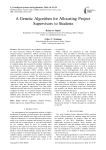
A Genetic Algorithm for Allocating Project Supervisors to Students
Статья научная
Research projects are graduation requirements for many university students. If students are arbitrarily assigned project supervisors without factoring in the students' preferences, they may be allocated supervisors whose research interests differ from theirs or whom they just do not enjoy working with. In this paper we present a genetic algorithm (GA) for assigning project supervisors to students taking into account the students' preferences for lecturers as well as lecturers' capacities. Our work differs from several existing ones which tackle the student project allocation (SPA) problem. SPA is concerned with assigning research projects to students (and sometimes lecturers), while our work focuses on assigning supervisors to students. The advantage of the latter over the former is that it does not require projects to be available at the time of assignment, thus allowing the students to discuss their own project ideas/topics with supervisors after the allocation. Experimental results show that our approach outperforms GAs that utilize standard selection and crossover operations. Our GA also compares favorably to an optimal integer programming approach and has the added advantage of producing multiple good allocations, which can be discussed in order to adopt a final allocation.
Бесплатно

